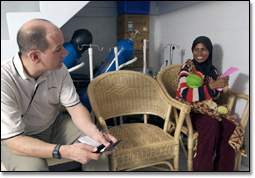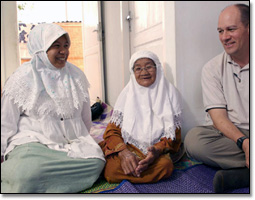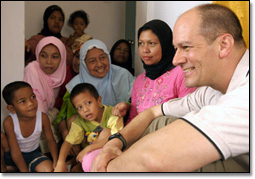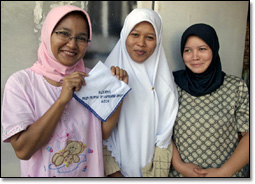Bob Seipel, a program manager for Boeing Space & Intelligence Systems Mission Systems, is reporting for Boeing News Now this week from Banda Aceh, Indonesia. He is part of a delegation led by the company's Global Corporate Citizenship function to investigate the progress of the rebuilding in Aceh province on the island of Sumatra, one of the areas hit hardest by the December 2004 Southeast Asian tsunami.
Boeing employees and retirees' donations accounted for nearly $2 million of the total Boeing contributions of $4.5 million split among three international relief agencies -- the American Red Cross, Mercy Corps and CARE, the latter two of which are sponsoring this site investigation. It is Seipel's responsibility on this trip to be the eyes and ears of Boeing employees and retirees who gave so generously to this disaster and to report back on how their dollars and those of the company are being spent in the relief efforts.
Each days events: Day 1, Day 2, Day 3, Day 4, Day 5
Day 5, FEB 2:
Collaboration and accountability

The Boeing group traveled to Lambaro Skep to visit the Puskesmas Pembantu Health Clinic, one of four provincial clinics built by CARE in conjunction with the Johns Hopkins International Program for Gynecology and Obstetrics. Here, Boeing's Bob Seipel talks with a woman who delivered her baby at the clinic a few months ago. Saying she was very shy, she agreed to talk only if Seipel sat two seats away. (Photo courtesy of CARE)
It's hard to believe our week in Banda Aceh is coming to a close. We've met some amazing people with amazing stories to tell -- including the dedicated CARE and Mercy Corps humanitarian workers we've spent time with here.
While these organizations have different approaches and areas of focus, both share a common commitment to measurement against stated objectives, regular evaluation of the progress made against these objectives, and holding themselves and their beneficiaries accountable for ensuring that the funds being spent are achieving the greatest possible impact.
"We couldn't do this work without an effective measurement and evaluation system," said Christophe LaGrand, director of CARE's programs in Aceh.
I'd like to briefly share with you the methodology that CARE uses to design, monitor and evaluate (DME) its programs and projects in all parts of the world, including this one. It is considered among the best by the community of nongovernmental organizations (NGOs) of which CARE is a part. Mercy Corps uses a similar methodology. The full cycle of CARE's program and project DME includes these phases:

Seipel visits with an 85-year-old grandmother named Ibu Zainabum and her granddaughter, Yulie Dian Melani. The grandmother lost two of her grandchildren in the tsunami -- both were staying at her house while she was away. Thanks to CARE, she is in a new house on the same land as the old one. Her granddaughter lives in transitional housing next door. (Photo courtesy of CARE)
- Diagnosis (assessment) of needs and opportunities in the target community
- Design of a project based on the findings of the diagnosis
- Summary of the design cause-effect logic in the form of Logframe Analysis (also used by Mercy Corps), a management tool used to record and track output outcomes and impact of projects
- The development of a sufficiently detailed plan for monitoring and evaluation (M&E) to guide those responsible for this during the life of the project
- The conducting of a baseline study consistent with the M&E plan
- Monitoring the process of implementation; using monitoring information to guide management decisions during the life of the project
- Periodic evaluations (typically mid-term and final), both quantitative and qualitative, to verify that the project is meeting/has met its objectives
- Applying key lessons learned from these evaluations to the design of other projects and the development of subsequent strategies
In addition, both CARE and Mercy Corps have signed on to the Humanitarian Accountability Principles, a new project that a number of NGOs are becoming involved with as a cross check to their own M&E programs. The project provides mechanisms for beneficiary complaints and feedback as another means to measure progress and success. The CARE office here has a full-time Humanitarian Accountability Principles expert on staff who trains workers on communicating with beneficiaries and designing programs with the best interests of the community in mind.

Seipel talks with members of a successful woman's cooperative that makes and sells cake and other pastries. The cooperative received a cash grant from CARE that it used to expand into catering for weddings and parties. (Photo courtesy of CARE)
Besides sharing common practices of measurement, representatives of the 18 international NGOs here meet every Monday to ensure their projects are coordinated and complementary. Additionally, every Friday, these NGOs attend a more formal meeting chaired by the United Nations, called the Inter-agency Steering Committee, as a means for additional information-sharing and collaboration.
There is a lot more to it than what I've described, but this should give you a fairly good idea about these NGOs' commitment to collaboration and accountability -- to themselves and their respective visions, to their beneficiaries, and to their contributors, such as Boeing and its employees and retirees.
Boeing also is committed to accountability and collaboration in the work we do in this area. The company, through its Global Corporate Citizenship function, holds itself accountable to our shareholders, which includes our employees, to be conscientious stewards of corporate and employee contributions. Similarly, the function collaborates closely with the recipient organizations to ensure the best possible outcome. Based on my experiences this week, I think they are doing a good job.

Seipel talks with members of a successful woman's cooperative that makes and sells cake and other pastries. The cooperative received a cash grant from CARE that it used to expand into catering for weddings and parties. (Photo courtesy of CARE)
I'd also like to thank my other fellow travelers for their enthusiasm and support as we've spent this week together, including Marilyn Grist, CARE USA (Atlanta), Peter Blomquist, Mercy Corps (Seattle), and our wonderful photographer, David Evans, whose day job actually is in frontline fund-raising for Mercy Corps in Portland.
Thanks also to Paul Walters, Boeing International vice president for Southeast Asia, and Susan Birkholtz, a communicator supporting Global Corporate Citizenship from our Chicago office.
I'd like to congratulate my fellow Boeing employees for their amazing generosity of spirit as well as their contributions. I can assure you that the money you donated through the Employees Community Fund in early 2005 to help the people of Aceh province -- and I am confident those in the other affected countries as well -- is being put to good use rebuilding lives and livelihoods. The people I've met here are independent, resourceful and incredibly resilient. They are grateful for our support and intent on using it to make a brighter future for themselves and their children. I leave here feeling very satisfied indeed.
|

